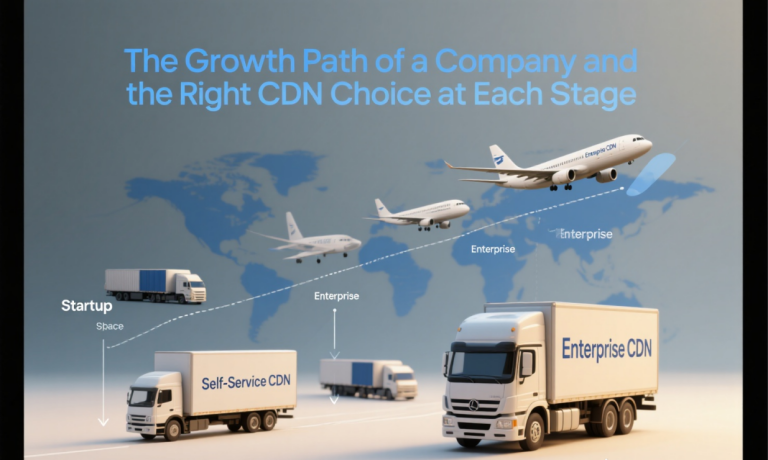
Your business is taking off. That scrappy startup you launched from your garage is now a serious contender. Your user base is growing, your revenue is climbing, and your ambitions are expanding beyond your home country’s borders. But with this growth comes a new, more complex set of challenges.
The simple, self-service CDN that was your best friend in the early days—the one you signed up for with a credit card in five minutes—is starting to show its limits. The performance is good, but not great. The security features are a black box. And when you had a critical issue last month, “customer support” was a community forum and a prayer.
You look at the so-called “Enterprise” CDN platforms. They talk about dedicated support, enterprise-grade security, and guaranteed SLAs. It sounds powerful. It also sounds expensive, complicated, and involves talking to sales teams—a world away from the instant gratification of your self-service tool.
So, what do you do? When is the right time to graduate? Is it even necessary?
This isn’t just a technical question; it’s a question of business maturity. Choosing a CDN platform is like choosing the right logistics partner for your growing manufacturing business. In the beginning, renting a U-Haul truck and doing everything yourself is the smart, cost-effective choice. But there comes a point where, to scale your operations globally and protect your high-value goods, you need to partner with a professional logistics firm like FedEx or DHL.
Knowing when to make that leap is one of the most critical infrastructure decisions a growing business can make. Today, we’re not going to sell you a solution. We’re going to provide you with a framework—a maturity matrix—to help you diagnose your own business and decide for yourself which philosophy of content delivery is right for you, right now.
Chapter 1: The Two Philosophies - Defining the Landscape
Before you can choose a path, you must understand the destinations. The CDN market is broadly divided into two philosophical approaches.
The Self-Service Philosophy: The U-Haul Rental
This is the model that has empowered a generation of developers and startups. It’s built on a foundation of automation, documentation, and a credit card.
Who it’s for: Individual developers, hobbyists, small blogs, and early-stage startups testing an MVP (Minimum Viable Product).
The Core Promise: “Here are the keys to a powerful truck. It’s fueled up and ready to go. The instruction manual is in the glove box. Good luck with your move.”
The Experience: You sign up online, often with a generous free tier. The dashboard is usually slick and designed to get you up and running in minutes for standard use cases (like caching a simple website). You are given full control, which is both empowering and a significant responsibility.
The Unspoken Agreement: The low cost or free entry point comes with an implicit understanding: you are largely on your own. Support is typically limited to documentation and community forums. Advanced features are either unavailable or locked behind higher, more expensive tiers that blur the line into the enterprise model.
The Enterprise Philosophy: The FedEx Partnership
This model is built not just on technology, but on a human partnership. It’s a solution designed for businesses where performance and security are not just features, but core business requirements.
Who it’s for: Scaling e-commerce platforms, FinTech companies, SaaS businesses, gaming studios, and media outlets.
The Core Promise: “Don’t just rent our trucks. Hire our entire team of logistics experts. Tell us what you need to ship, where it needs to go, and how secure it needs to be, and we will architect a custom, global logistics solution for you, backed by a 24/7 support team and a legally binding service level agreement (SLA).”
The Experience: The process usually starts with a conversation. A solutions architect works with your team to understand your specific challenges. The platform is more of a toolbox of powerful, often complex, features that can be combined to solve unique problems. The price is typically negotiated based on your needs, and the relationship is governed by a contract.
So, which is right for you? To answer that, you need to turn the spotlight inward and honestly assess your own business’s stage of maturity across a few key dimensions.
Chapter 2: The Maturity Matrix - A Diagnostic for Your Business
Let’s go through a checklist. Be honest about where your business falls on the spectrum for each of these five axes.
Axis 1: Your Team’s Technical Expertise & Focus
Early Stage: You have a small team, maybe just one or two developers who are responsible for everything—from writing code to managing the infrastructure. Their time is the most precious resource in your company. They need tools that “just work” and have a low cognitive overhead.
Verdict: A Self-Service platform is a perfect fit. It allows the team to get a CDN up and running quickly without a steep learning curve, so they can get back to building the core product.
Growth Stage: You now have a dedicated DevOps, SRE, or platform engineering team. Their job is to manage and optimize infrastructure. They are comfortable with complexity, but they are also stretched thin. They don’t have time to become world-class experts in the arcane art of BGP routing or DDoS mitigation.
Verdict: This is the crossover point. Your team is capable of handling an advanced tool, but they would benefit immensely from a partner who can act as an extension of their team. An Enterprise platform with expert support means your team isn't reinventing the wheel; they're learning from and collaborating with the best in the business.
Axis 2: Your Performance Requirements
Early Stage: Your goal is simple: “make the site faster than it was without a CDN.” Basic caching of static assets (images, CSS, JS) is enough to provide a huge, noticeable improvement.
Verdict: Self-Service platforms excel at this core function.
Growth Stage: The conversation changes. You’re no longer just talking about “fast.” You’re talking about your Core Web Vitals. You’re obsessing over your Time to First Byte (TTFB). You realize that the real performance bottlenecks are in your dynamic content and API calls. You need a global network that can provide consistently low latency not just for static files, but for the very logic of your application.
Verdict: This is squarely in Enterprise territory. Advanced capabilities like Dynamic Site Acceleration, API acceleration, and programmable Edge Computing are the tools needed to solve these complex performance challenges.
Axis 3: Your Security & Compliance Posture
Early Stage: Your security needs are basic. You need an SSL certificate and a simple firewall to block nuisance attacks.
Verdict: Most Self-Service platforms provide this baseline level of security for free or at a low cost.
Growth Stage: Security is now a board-level conversation.
You are expanding into Europe and your legal team is asking how you’re going to handle GDPR compliance.
You are in the FinTech space and you must be PCI DSS compliant.
Your e-commerce site is being targeted by sophisticated scalper bots that are ruining your product launches.
You just read about a new zero-day vulnerability and you need a way to deploy a virtual patch now.
Verdict: These are advanced security challenges that require an Enterprise-grade WAF, sophisticated bot management, and granular controls for data sovereignty. This is a primary driver for graduating to an enterprise platform.
Axis 4: The Criticality of Uptime & Support
Early Stage: Your business is a personal blog or a simple marketing site. If it goes down for an hour in the middle of the night, it’s embarrassing, but the financial impact is negligible.
Verdict: Relying on a Self-Service platform’s community forum for support is an acceptable risk.
Growth Stage: Your business is a revenue-generating machine. You’ve calculated that one hour of downtime during peak business hours costs you $50,000 in lost sales and damages your brand’s reputation.
Verdict: You can no longer afford to be on your own. You need a partner with a financially-backed SLA that guarantees uptime. More importantly, you need a phone number you can call at 3 AM and get a senior network engineer on the line within minutes to help you solve a critical problem. This level of support is the very definition of an Enterprise service.
Chapter 3: The Graduation Day - Signs It's Time to Switch
How do you know when you’ve reached the tipping point? Here are a few clear signals that your business has outgrown its U-Haul truck and needs to partner with a global logistics firm:
Your First Real Security Scare: You experience a sophisticated application-layer DDoS attack or a bot attack that your self-service provider is unable to mitigate.
The Support Black Hole: You have your first critical, revenue-impacting outage and realize you have absolutely no one to call for expert help.
The Performance Plateau: You’ve optimized everything you can, but your global performance is still being held back by a lack of advanced features like dynamic acceleration or edge computing.
The International Leap: You are making a serious push to expand into a new continent (like Asia, Europe, or South America) and you need a partner with deep regional network expertise and knowledge of local compliance laws.
The Big Customer Arrives: A major enterprise client is about to sign a huge contract, but their security team hands you a 50-page vendor risk assessment questionnaire that includes questions about SOC 2 compliance, custom WAF rules, and your DDoS mitigation plan.
If you are experiencing any of these, it’s time. The cost of not upgrading will soon far outweigh the cost of the enterprise service itself.
This is not a story of “good” versus “bad.” A self-service CDN is an incredible, empowering tool for the right stage of a company’s journey. A U-Haul truck is a brilliant invention. But the mistake is trying to build a global, just-in-time supply chain using a fleet of rental trucks.
The choice of a CDN partner is a reflection of your company’s maturity and its ambition. As your business grows, the complexity and the stakes grow with it.
A true enterprise CDN partner understands this. They provide not just the infrastructure, but the expertise and the support to help you navigate this complexity. They become an extension of your own team.
Platforms like Cloudflew are designed to bridge this gap, offering the power and expert support of an enterprise solution with the agility and ease-of-use that a growing business demands. It’s the partner that can be your U-Haul for your first move, and then seamlessly become your global fleet of cargo jets as you conquer the world.
Choosing a CDN is choosing a partner for your journey. Choose one that isn’t just built for where you are today, but is ready to take you where you want to go tomorrow.

